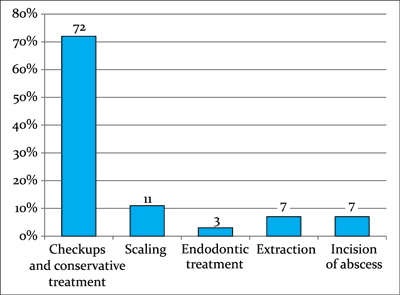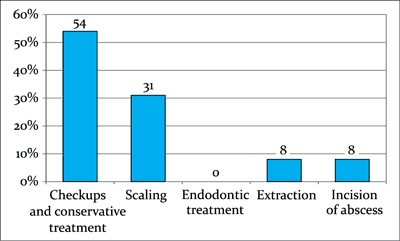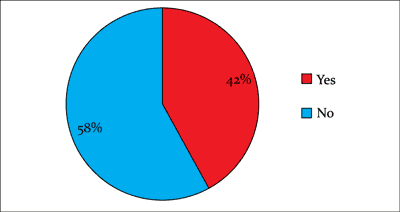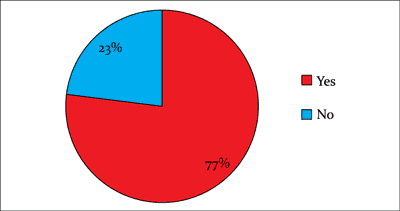Małgorzata Lipczyńska1, Anna Kuzańska1, Joanna Szczepańska2, *Patrycja Proc2
Assessment of mothers’ knowledge on the principles of prophylaxis and oral cavity hygiene during pregnancy and in the neonatal-infantile period
Ocena wiedzy matek na temat zasad profilaktyki i higieny jamy ustnej w okresie ciąży oraz u ich dzieci w wieku niemowlęcym
1Students’ Research Circle, Department of Paediatric Dentistry, Medical University of Łódź
2Department of Paediatric Dentistry, Medical University of Łódź
Head of Department: Professor Joanna Szczepańska, DMD, PhD
Streszczenie
Wstęp. Edukacja i wprowadzanie zasad profilaktyki przeciwpróchnicowej i higieny wśród matek zapobiega chorobom jamy ustnej wśród ich dzieci.
Cel pracy. Celem pracy była ocena zakresu wiedzy matek dotycząca profilaktyki i higieny jamy ustnej w okresie ciąży oraz u ich dzieci w wieku noworodkowym i niemowlęcym.
Materiał i metody. Badaniem ankietowym objęto 50 kobiet, w tym 28 (56%) pierworódek oraz 22 (44%) matek posiadających jedno lub więcej dzieci. Analizowano: wpływ wieku, wykształcenie, miejsce zamieszkania, liczbę dzieci, profilaktykę przeciwpróchnicową i wiedzę na temat zdrowia jamy ustnej na zachowania pro-zdrowotne kobiet w odniesieniu do nich samych oraz ich dzieci.
Wyniki. U 30 kobiet (60%) przeprowadzono leczenie stomatologiczne w czasie ciąży, w tym u 11 (22%) w II trymestrze. 17 z 45 (38%) matek mieszkających w mieście oraz 4 z 5 (80%) na wsi udało się do stomatologa przed zajściem w ciążę. 22 (44%) kobiet stosowało dodatkowe środki higieny jamy ustnej w czasie ciąży, a 29 (58%) matek wykazało się prawidłową wiedzą dotyczącą zasad higieny jamy ustnej dziecka. 35 (70%) matek w odpowiednim czasie wprowadziło dzieciom szczoteczkę, a 31 (62%) pastę do zębów. W większości były to matki do 30. roku życia – 17 (55%), z miast – 27 (87%), z wykształceniem wyższym lub średnim – 26 (84%).
Wnioski. Lekarze stomatolodzy powinni wykazywać większe zaangażowanie w edukacji matek dotyczącej zachowań prozdrowotnych w zakresie jamy ustnej u ich dzieci.
Summary
Introduction. Education and introducing cariostatic prophylaxis to mothers prevents oral cavity diseases in their children.
Aim. The purpose of the study was to assess the scope of knowledge of mothers concerning the prophylaxis and oral cavity hygiene during pregnancy and in their children’s earliest stage of life.
Material and methods. A survey study covered 50 women divided into two groups: primiparas 28 (56%) and mothers with one or more older children 22 (44%). The relationship between age, education level, place of residence, and number of children on the awareness of caries prevention and pro-health behaviour in respect to their own and their children’s health was analyzed.
Results. 30 (60%) women received dental treatment during pregnancy, including 11 (22%) in 2nd trimester. 17 of 45 (38%) city-based mothers 4 out of 5 (80%) country-based mothers arranged a dental appointment(s) before pregnancy. 22 (44%) women applied additional oral hygiene measures during pregnancy, and 29 (58%) mothers showed adequate knowledge about their child’s oral hygiene. 35 (70%) mothers timely introduced a toothbrush and 31 (62%) began using a toothpaste. These were mostly women up to 30 years old – 17 (55%), city-based – 27 (87%), with higher and secondary education level 26 (84%).
Conclusions. Dentists should be more actively engaged in proper education of mothers concerning pro-health behavior related to oral hygiene of infants.

Introduction
At the moment of birth, the oral cavity of a newborn is sterile. In the course of the next few days, it is colonized by streptococci and other bacteria from the mother, potentially leading to diseases of the mucosa and hard tissues of the tooth (1, 2). Education, introducing the principles of caries prevention and proper oral hygiene among mothers and pregnant women may prevent caries in infants and small children. This obligation applies equally to the mother and the dentist (2, 3). New guidelines concerning cariostatic prevention issued in 2015 by the Polish Association of Pediatric Dentistry (Polskie Towarzystwo Stomatologii Dziecięcej – PTSD) and the Alliance for a Cavity-Free Future (ACFF) are aimed at preventing and fighting early childhood caries (ECC) (4, 5). According to the data from 2009-2011 Programme for Monitoring the Health of the Oral Cavity (Monitoring Zdrowia Jamy Ustnej), as much as 57.2% three-year-olds and 79.9% five-year-olds suffer from caries (6, 7). These are very high rates. The underlying causes are believed to include poor eating and hygienic habits, poor social-economic conditions, Polish parents’ lack of knowledge about caries prevention, as well as a lack of commitment on the part of dentists and paediatricians as regards popularizing relevant knowledge (1, 2, 7). PRE-PO-NAT programme is used to promote fluoride and hygienic prophylaxis among Polish pregnant women and new mothers (8).
Aim
The aim of the study was to assess the mothers’ scope of knowledge concerning the prophylaxis and hygiene of the oral cavity during pregnancy and in neonates and infants. The role of the dentist in propagating the guidelines concerning dental care of young children was also assessed.
Material and methods
The survey covered 50 women, including 28 (56%) primiparas and 22 (44%) mothers who already had one or more children. The surveyed women were between 20 and 45 years old. The study was conducted in Madurowicz Teaching Hospital in Łódź in January 2016. The analysis included the impact of the mother’s age, education level, place of residence, and the number of children on the preventive measures used and on her scope of knowledge as regards her own and her newborn child’s oral health.
Statistical analysis was conducted with the use of Excel and Statistica 12.0 software, assuming p < 0.05 as statistically significant. Chi2 test was used for the statistical assessment.
Results
30 women (60%) underwent dental treatment during pregnancy, 11 (22%) of them in the second trimester (chi2 = 4.57; p < 0.05). In most cases (55%), dental treatment consisted in a dental checkup exam, while endodontic treatment was the rarest at 17% (fig. 1). In the second trimester of pregnancy, conservative treatment of cavities and dental checkups were the most common among the conducted procedures at 54% (fig. 2). Also the most invasive procedures, such as extractions and abscess incisions, were conducted in the safest period, that is the second trimester, of pregnancy. They accounted for 16% of the conducted procedures.

Fig. 1. The procedures performed during the whole period of pregnancy in the women covered by the study

Fig. 2. The procedures performed during the second trimester of pregnancy in the women covered by the study
As many as 29 (58%) of the surveyed mothers did not receive dental care in the period before their planned pregnancy (fig. 3). Only 13 (26%) of the surveyed women were informed by the dentist about the impact of the mother’s dental health on a newborn’s health. In this group, 10 out of 13 (77%) women arranged a dental appointment prior to getting pregnant (p < 0.05) (fig. 4). A statistically significant correlation was proven between planning dental treatment before pregnancy and the place of residence. Among mothers living in the city, only 17 out of 45 (38%) had a dental checkup before getting pregnant, whereas 4 out of 5 (80%) country-based mothers were examined by the dentist at that time (x2 = 9.623; p < 0.05).

Fig. 3. Dental care coverage before pregnancy

Fig. 4. Dental checkup before pregnancy among informed women
Powyżej zamieściliśmy fragment artykułu, do którego możesz uzyskać pełny dostęp.
Mam kod dostępu
- Aby uzyskać płatny dostęp do pełnej treści powyższego artykułu albo wszystkich artykułów (w zależności od wybranej opcji), należy wprowadzić kod.
- Wprowadzając kod, akceptują Państwo treść Regulaminu oraz potwierdzają zapoznanie się z nim.
- Aby kupić kod proszę skorzystać z jednej z poniższych opcji.
Opcja #1
29 zł
Wybieram
- dostęp do tego artykułu
- dostęp na 7 dni
uzyskany kod musi być wprowadzony na stronie artykułu, do którego został wykupiony
Opcja #2
69 zł
Wybieram
- dostęp do tego i pozostałych ponad 7000 artykułów
- dostęp na 30 dni
- najpopularniejsza opcja
Opcja #3
129 zł
Wybieram
- dostęp do tego i pozostałych ponad 7000 artykułów
- dostęp na 90 dni
- oszczędzasz 78 zł
Piśmiennictwo
1. Chorzewska E, Wasilczuk U, Marczuk-Kolada G et al.: Wpływ nawyków żywieniowych i wykształcenia rodziców na intensywność próchnicy u dzieci w wieku przedszkolnym. Nowa Stomatol 2015; 20(4): 142-148. 2. Opydo-Szymaczek J, Borysewicz-Lewica M: Opieka stomatologiczna nad kobietą w ciąży w aspekcie profilaktyki próchnicy – przegląd piśmiennictwa. Czas Stomatol 2005; 58(3): 149-154. 3. Grzesiak I, Kaczmarek U: Wiedza prozdrowotna matek i świadomość stanu uzębienia ich dzieci w wieku do lat 3. Dent Med Probl 2004; 41(1): 59-66. 4. Olczak-Kowalczyk D, Borysewicz-Lewicka M, Adamowicz-Klepalska B et al.: Consensus statement of Polish experts on individual caries prevention with fluoride in children and adolescents. Nowa Stomatol 2016; 21(1): 47-73. 5. Szczepańska J, Daszkowska M, Hilt A, Marczuk-Kolada G: Zalecenia higieniczne w obrębie jamy ustnej dla dzieci i młodzieży. Nowa Stomatol 2015; 20(3): 125-130. 6. Wierzbicka M, Strużycka I, Szatko F, Ganowicz M: Zdrowie jamy ustnej w Polsce na przełomie pierwszej i drugiej dekady XXI wieku. Stomatol Współcz 2012; 19: 18-16. 7. Szafrańska B, Waszkiel D: Frekwencja i intensywność próchnicy u dzieci w wieku od 3 do 7 lat, mieszkających w Białymstoku. Czas Stomatol 2008; 61(7): 480-487. 8. Trykowski J: Optymalna fluorowa profilaktyka próchnicy zębów w Polsce. Czas Stomat 2005; 58(6): 379-392. 9. Thumar DS, Bagda DK: Dental considerations in pregnancy. Natl J Integr Res Med 2015; 6(1): 93-97. 10. Gmyrek-Marciniak A, Wilk-Sieczak B: Zapobieganie próchnicy u dzieci do lat trzech. Mag Stomat 2001; 7-8: 48-52. 11. Proc P, Filipińska-Skąpska R, Wochna-Sobańska M: Próchnica uzębienia dzieci łódzkich do lat 5. II. Zachowania zdrowotne matek. Dent Med Probl 2005; 42(4): 567-571. 12. Bruzda-Zwiech A, Filipińska R, Szydłowska-Walendowska B et al.: Stomatologiczne zachowanie prozdrowotne 4-5-letnich dzieci w świetle badań ankietowych rodziców. Dent Med Probl 2012; 49(2): 272-278. 13. Proc P, Filipińska-Skąpska R, Wochna-Sobańska M: Próchnica uzębienia dzieci łódzkich do lat 5. IV. Higiena i profilaktyka fluorkowa. Dent Med Probl 2006; 43(4): 530-534. 14. Sankeshwari RM, Ankola AV, Tangade PS, Hebbal MI: Association of socio-economic status and dietary habits with early childhood caries among 3- to 5-year-old children of Belgaum city. Eur Arch Paediatr Dent 2013; 14: 147-153. 15. Al-Hosani E, Rugg Gunn A: Combination of low parental educational attainment and high parental income related to high caries experience in preschool children in Abu Dhabi. Community Dent Oral Epidemiol 1998; 26: 31-36. 16. Szczepańska J, Lubowiedzka-Gontarek B, Pawłowska E, Szydłowska-Walendowska B: Czynniki ryzyka próchnicy związane z żywieniem a liczebnością bakterii próchnicotwórczych w ślinie dzieci w wieku 3 lat. Dent Med Probl 2008; 45: 156-164. 17. Mello T, Anlunes J, Waldman E, Meio E: Health differentials in rural and urban areas: prevalence of dental caries and malocclusion in Brazilian context. J Epidemiol Community Health 2004; 58: 100. 18. Rybarczyk-Townsend E, Lubowiedzka B, Wochna-Sobańska M: Stan uzębienia dzieci 6-letnich w województwie łódzkim w roku 2005. Prz Epidemiol 2007; 61: 593-599. 19. Levin KA, Davies CA, Douglas GV, Pitts NB: Urban-rural differences in dental caries of 5-year old children in Scotland. Soc Sci Med 2010; 71(71): 2020-2027.




